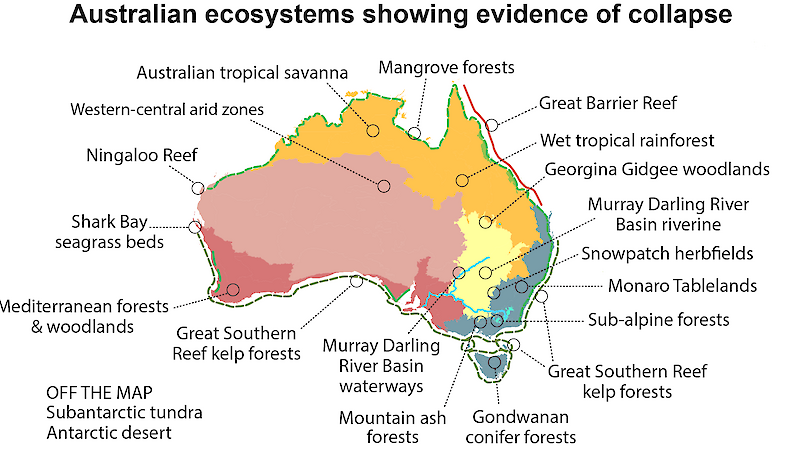A collaborative scientific effort is documenting changes in key ecosystems around Australia and Antarctica that provide warning signs of irreversible collapse.
A report entitled "Combating ecosystem collapse from the tropics to the Antarctic", by 38 scientists from universities and government agencies, is published today in the international journal Global Change Biology.

Lead author, Dr Dana Bergstrom from the Australian Antarctic Division, said the project emerged from a 2018 conference inspired by her ecological research in polar environments.
"I was seeing unbelievably rapid, widespread dieback in the alpine tundra of World Heritage-listed Macquarie Island and started wondering if this was happening elsewhere," Dr Bergstrom said.
"With my colleagues from the Australian Antarctic Division and the University of Queensland we organised a national conference and workshop on 'Ecological Surprises and Rapid Collapse of Ecosystems in a Changing World', with support from the Australian Academy of Sciences."
"It allowed us to bring together expertise from across the nation to understand how to recognise warning signs from nature and be prepared to make a difference."
"Despite working in vastly different regions, many other scientists around Australia are also observing signs of those ecosystems collapsing."
"Ecosystem collapse means these places are experiencing potentially irreversible environmental changes, including loss of important species such as dominant trees, and loss of functions such as pollinators," Dr Bergstrom said.
From mangroves to moss beds
The resulting paper and extensive case studies examine recent collapses in marine and terrestrial ecosystems across all Australian states, spanning 58° of latitude from coral reefs to Antarctica.
"We documented 19 examples, which include mangroves in the Gulf of Carpentaria, the arid zone of central Australia, Shark Bay seagrass beds in Western Australia, Great Southern Reef kelp forests, Mountain Ash forest in Victoria, and moss beds of East Antarctica."
"None of the 19 ecosystems has yet collapsed across its entire range, but for all case studies there is documented evidence of major change in at least some areas."
Dr Bergstrom said that the study can be used to focus on the damaging processes and recognise the early warning signs of dramatic change, so that environmental managers can target interventions to prevent the loss of any of these ecosystems in their entirety.
"The causes of the collapses are varied and include long-term pressures such as changed climate, habitat loss and pest species, but also short-term pressures such as heatwaves, storms and fires."
Chronic and acute pressures happening at the same time with increasing intensity can cause ecosystems to shift from their baseline state and reach tipping points.
"Such changes exhibit a range of patterns such as abrupt, smooth, stepped or fluctuating. Recognising these patterns can alert environmental managers to impending collapse."
The authors describe three 'A's to assist with identifying the key stages in preventing further ecosystem collapse - increasing awareness of the risks to ecosystems, anticipation of likely impacts of those risks to these ecosystems, and actions to mitigate those risks.
Fire protection a key action
Native conifer rainforests in the Southwest Tasmanian Wilderness World Heritage Area are one of the unique ecosystems showing evidence of collapse, according to Dr Justine Shaw, a conservation scientist from the University of Queensland.
"These ancient forests are the only place you will find species like majestic King Billy and pencil pines, which can be over 1000 years old," said Dr Shaw.
"The forests and their peat soils are very vulnerable to fire, which is becoming increasingly frequent and intense in the region due to climate change."
The paper highlights the interventions by the managers of the World Heritage Area to identify fire-prone ecosystems, prepare for an increased frequency of ignitions from dry lightning strikes, and install sprinkler systems to protect forests in the path of wildfires.
"In recent years active fire-fighting, including irrigated fire breaks, has provided some protection and must be sustained to protect these spectacular forests," Dr Shaw said.
Future-proofing
The scientific team concluded that in the near future, even apparently resilient ecosystems can reach tipping points where they can suddenly suffer collapse as the intensity and frequency of pressures increase.
"Anticipating and preparing for future change is necessary for most ecosystems, unless we are willing to accept a high risk of loss," Dr Bergstrom said.
"While the environmental change we see can be disturbing, I'm pleased to be part of a team sharing information that can guide decision-making to future-proof the ecological wealth that underpins our society."






